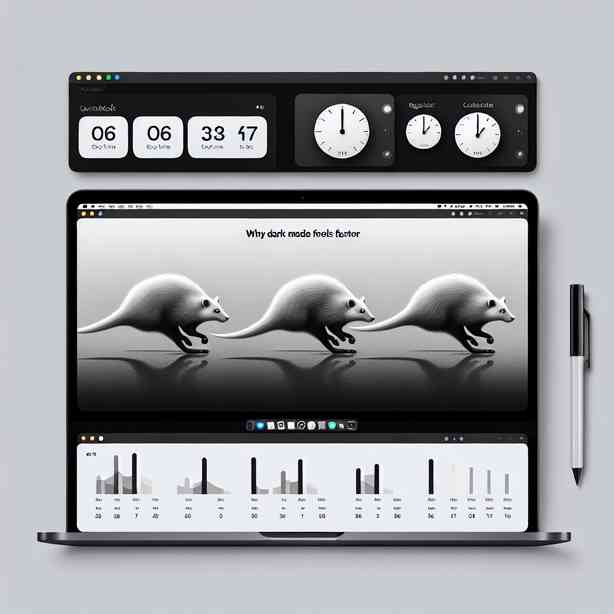
Dark mode has become increasingly popular across various devices and applications in recent years, and many users report a perception that it feels faster and more responsive than the traditional light mode. This phenomenon can be attributed to several interconnected factors, ranging from psychological impact to technical aspects of display technology. Understanding these factors can provide insight not only into user experience but also into the design choices made by developers and designers.
Firstly, the psychological component plays a crucial role in how users perceive speed and responsiveness. Dark mode tends to create a more immersive experience by reducing glare and eye strain, especially in low-light environments. This ambient lighting condition fosters a sense of comfort, leading users to become more engaged with their device. When we feel comfortable, we are less likely to notice minor delays or lags in performance. Consequently, tasks may seem to be completed more quickly than they actually are, simply because our focus is not diverted by discomfort.
Moreover, dark mode alters our perception of time. Studies have shown that people often perceive time to pass more quickly in environments with less lighting. This can be attributed to fewer distractions that light sources can cause, allowing users to concentrate on their tasks. As such, when using applications or systems in dark mode, users may feel as though they are working faster compared to using light mode. This perception can affect productivity, making individuals feel more efficient, and leading them to favor dark mode for extended periods.
On a technical level, dark mode can also contribute to speed through its interaction with energy consumption on various devices. For example, devices utilizing OLED (Organic Light Emitting Diode) technology consume less power when displaying darker colors. Each pixel in an OLED display emits its own light, meaning that darker pixels are powered down entirely, resulting in improved battery life. This efficiency can lead to smoother performance, as devices are less likely to experience thermal throttling when battery consumption is optimized. With extended battery life, users can enjoy prolonged sessions without the concern of slowdowns related to battery performance.
In addition, many modern operating systems and applications are optimized for dark mode. Developers often prioritize performance for dark themes, ensuring that UI elements are rendered efficiently and responsively. This can be particularly true in gaming and graphic-intensive applications where dark backgrounds are common. As such, programmers might optimize code paths that are invoked more frequently in dark mode, deliberately enhancing the overall experience and responsiveness of the application. This level of attention to detail helps reinforce the feeling of increased speed.
Another aspect to consider is how dark mode influences task visualization. With high contrast in dark mode, certain elements become more distinguishable, allowing users to navigate and work more efficiently. Text and icons often appear bolder and more defined against a dark background, leading to quicker recognition and less visual confusion. When users can rapidly identify what they need, they can execute tasks more swiftly, contributing to the overall perception of speed.
Furthermore, there is a cultural context associated with dark mode that plays into its popularity. In tech circles, dark mode has often been associated with productivity, focus, and modernity. This cultural significance can create a mindset where users expect to be more effective and faster when utilizing tools in dark mode. This expectation can manifest in behavior, leading users to work more efficiently when they believe they are experiencing an environment that enhances their productivity.
Moreover, the emotional and health-related benefits of dark mode cannot be overlooked. Prolonged exposure to bright screens can lead to eye fatigue, headaches, and discomfort, ultimately resulting in slower performance. In contrast, dark mode eases this strain, and users are likely to work longer and more effectively without the burden of discomfort. As users feel better, their efficiency naturally increases, aligning with the idea that dark mode feels faster.
User interface designers are also increasingly adopting principles that enhance the experience of dark mode. From reducing white flashes during transitions to optimizing loading screens for dark environments, these intentional design choices can significantly impact user perceptions of speed. When transitions are smoother, and elements fade in naturally, it creates an illusion of instantaneous responsiveness. A well-crafted interface that prioritizes user experience contributes to an efficient workflow.
To sum up, the feeling that dark mode is faster than light mode arises from a complex interplay of psychological and technical factors. The thoughtful design of user interfaces, the psychological comfort that darker environments provide, and the energy efficiency of modern displays all contribute to this perception. As technology continues to evolve, and as more individuals become accustomed to dark mode, it is likely that this sentiment will persist. In the end, whether you prefer light or dark mode may not just be a matter of aesthetic choice; it may very well impact your productivity and overall experience in significant ways.
Through understanding these dynamics, users can make more informed choices about how they interact with their devices, ultimately managing their workflows to suit their preferences and needs effectively. Embracing dark mode could very well mean adopting a tool that not only looks appealing but also enhances productivity and performance in subtle yet powerful ways.


